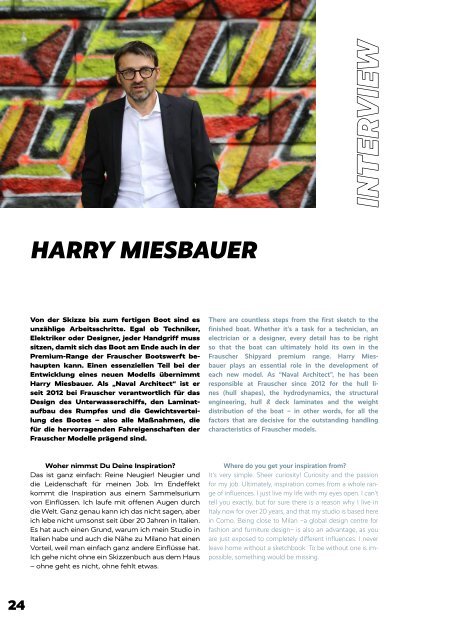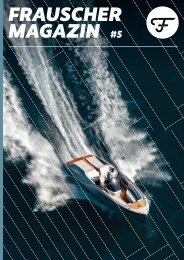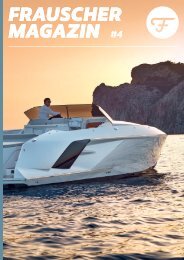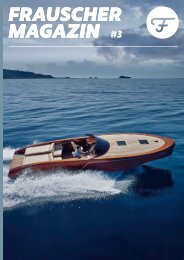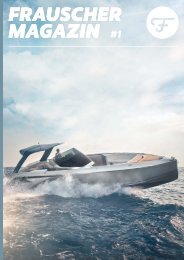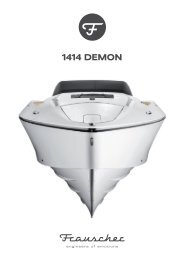Frauscher Magazin #2
The Frauscher shipyard gives insights into the design, the boat building and their model range in their first magazine! About the Frauscher shipyard: Frauscher Shipyard, with headquarters in Ohlsdorf, Austria, is unique in offering high-quality and innovative motor and electric boats that are valued by experts and boat enthusiasts from around the world: especially due to the striking design and superior craftsmanship – “Made in Austria”.
The Frauscher shipyard gives insights into the design, the boat building and their model range in their first magazine!
About the Frauscher shipyard:
Frauscher Shipyard, with headquarters in Ohlsdorf, Austria, is unique in offering high-quality and innovative motor and electric boats that are valued by experts and boat enthusiasts from around the world: especially due to the striking design and superior craftsmanship – “Made in Austria”.
Create successful ePaper yourself
Turn your PDF publications into a flip-book with our unique Google optimized e-Paper software.
HARRY MIESBAUER<br />
Von der Skizze bis zum fertigen Boot sind es<br />
unzählige Arbeitsschritte. Egal ob Techniker,<br />
Elektriker oder Designer, jeder Handgriff muss<br />
sitzen, damit sich das Boot am Ende auch in der<br />
Premium-Range der <strong>Frauscher</strong> Bootswerft behaupten<br />
kann. Einen essenziellen Teil bei der<br />
Entwicklung eines neuen Modells übernimmt<br />
Harry Miesbauer. Als „Naval Architect“ ist er<br />
seit 2012 bei <strong>Frauscher</strong> verantwortlich für das<br />
Design des Unterwasserschiffs, den Laminataufbau<br />
des Rumpfes und die Gewichtsverteilung<br />
des Bootes – also alle Maßnahmen, die<br />
für die hervorragenden Fahreigenschaften der<br />
<strong>Frauscher</strong> Modelle prägend sind.<br />
Woher nimmst Du Deine Inspiration?<br />
Das ist ganz einfach: Reine Neugier! Neugier und<br />
die Leidenschaft für meinen Job. Im Endeffekt<br />
kommt die Inspiration aus einem Sammelsurium<br />
von Einflüssen. Ich laufe mit offenen Augen durch<br />
die Welt. Ganz genau kann ich das nicht sagen, aber<br />
ich lebe nicht umsonst seit über 20 Jahren in Italien.<br />
Es hat auch einen Grund, warum ich mein Studio in<br />
Italien habe und auch die Nähe zu Milano hat einen<br />
Vorteil, weil man einfach ganz andere Einflüsse hat.<br />
Ich gehe nicht ohne ein Skizzenbuch aus dem Haus<br />
– ohne geht es nicht, ohne fehlt etwas.<br />
INTERVIEW<br />
There are countless steps from the first sketch to the<br />
finished boat. Whether it's a task for a technician, an<br />
electrician or a designer, every detail has to be right<br />
so that the boat can ultimately hold its own in the<br />
<strong>Frauscher</strong> Shipyard premium range. Harry Miesbauer<br />
plays an essential role in the development of<br />
each new model. As “Naval Architect”, he has been<br />
responsible at <strong>Frauscher</strong> since 2012 for the hull lines<br />
(hull shapes), the hydrodynamics, the structural<br />
engineering, hull & deck laminates and the weight<br />
distribution of the boat – in other words, for all the<br />
factors that are decisive for the outstanding handling<br />
characteristics of <strong>Frauscher</strong> models.<br />
Where do you get your inspiration from?<br />
It's very simple. Sheer curiosity! Curiosity and the passion<br />
for my job. Ultimately, inspiration comes from a whole range<br />
of influences. I just live my life with my eyes open. I can't<br />
tell you exactly, but for sure there is a reason why I live in<br />
Italy now for over 20 years, and that my studio is based here<br />
in Como. Being close to Milan –a global design centre for<br />
fashion and furniture design– is also an advantage, as you<br />
are just exposed to completely different influences. I never<br />
leave home without a sketchbook. To be without one is impossible,<br />
something would be missing.<br />
Gibt es eine besondere Handschrift,<br />
die Dich ausmacht?<br />
Beim Design eines neuen Bootes schauen wir immer<br />
darauf, dass es zeitlos ist und keinen Jahresstempel<br />
trägt. Es muss auch noch in zehn Jahren<br />
gut aussehen und immer eine gewisse Eleganz<br />
haben.<br />
Auf Grund meiner Vergangenheit – ich habe ja jahrelang<br />
nur Regatta-Boote gezeichnet – bin ich sehr<br />
Performance orientiert. Das ist nach wie vor im Blut<br />
drin. Bei uns geht es immer um das gesamte Produkt<br />
– es geht also nicht nur rein um das Design,<br />
denn das Boot muss am Ende ja auch funktionieren.<br />
Ich bin der Meinung, ein guter Designer ist auch<br />
der, der sein Produkt am Ende auch benutzt, weil<br />
er dann einfach weiß, ob es funktioniert oder nicht.<br />
Die Zeichnungen, die unser Studio verlassen – und<br />
dafür sind wir bekannt – sind quasi produktionsbereit<br />
und die Werft kann anfangen zu arbeiten.<br />
Und da lege ich großen Wert drauf. Unsere Entwürfe<br />
müssen realisierbar sein, sie müssen im Budget<br />
sein und natürlich die jeweilige CE-Zertifizierung<br />
schaffen.<br />
Was ist für Dich das Besondere am<br />
Boots-Design?<br />
Ich kenne ja nur das. Aber man muss sich vor Augen<br />
halten, dass Boots-Design ein Mix aus Transportation-Design<br />
und Architektur ist. Das Boot<br />
muss als schwimmende Villa, aber auch z.B. als Regatta-Boot<br />
funktionieren. Unser Geschäft ist immer<br />
ein Kompromiss. Boots-Design ist ungefähr so: Ich<br />
nehme einen Caravan und fahr mit dem eine Rallye.<br />
Das ist also recht schwierig.<br />
Beim Planen eines Bootes ist immer das Gewicht<br />
entscheidend: vom ersten Strich bis zum fertigen<br />
Boot. Ist das Boot schwerer als anfangs geplant,<br />
ist es nicht so schnell, wie man es eigentlich haben<br />
möchte. Stimmt der Schwerpunkt nicht, reicht die<br />
Performance oder der Fahrspaß nicht. Das Gewicht<br />
spielt also immer eine sehr große Rolle.<br />
Ein Boot muss einfach auf dem Meer draußen<br />
funktionieren, im sicheren Hafen funktionieren sie<br />
alle. Aber draußen ist die Herausforderung – das<br />
macht es schwierig. Da braucht man auch viel<br />
Erfahrung, um das Gefühl zu bekommen, ob etwas<br />
funktioniert oder nicht.<br />
Is there a particular touch that makes your<br />
designs special?<br />
When designing a new boat, we always make sure that it<br />
is timeless and is not tied to any particular year. It still has<br />
to look good in ten years' time and always have a certain<br />
elegance. Due to my past experience – for years I designed<br />
only regatta boats – I am very performance-oriented. That<br />
is still in my blood. For us, it's always about the overall product.<br />
So it's not just about the design, because at the end<br />
of the day the boat also has to be functional. In my opinion,<br />
a good designer is also someone who will be using his product.<br />
Because then he will really know whether it works or<br />
not. The drawings that leave our studio – and we are known<br />
for this – are almost ready for production and the shipyard<br />
can start working with them. And I put big emphasis<br />
on that. Our designs must be feasible, they must be within<br />
the budget and, of course, they must comply with the<br />
respective CE regulations.<br />
What is so special for you about yacht design?<br />
Actually, it's all I do. You just have to keep in mind that yacht<br />
design is a mix of transportation design and architecture.<br />
The boat must work as a floating villa, but also, for example,<br />
as a regatta boat. Our business is always a compromise.<br />
Yacht design is something like this: Take a camper van and<br />
go and do the Rally Dakar with it. So this is quite difficult.<br />
When designing a boat, the weight is always crucial – from<br />
the first line on the paper to the finished boat. If the boat is<br />
heavier than initially planned, it is not as fast as you would<br />
like it to be. If the centre of gravity is not correct, neither<br />
the performance nor the sailing pleasure is satisfactory.<br />
The weight therefore always plays a key role. A boat really<br />
has to work out on the open sea. They all work in a safe<br />
harbour. But out there is where the challenge is. That is what<br />
makes it difficult. You also need a lot of experience to get<br />
the feeling of whether something works or not.<br />
24<br />
25


